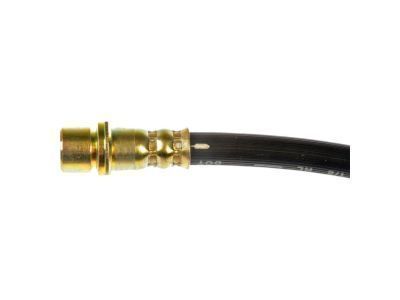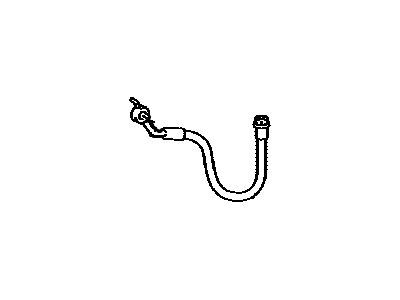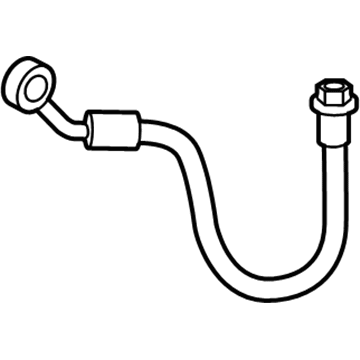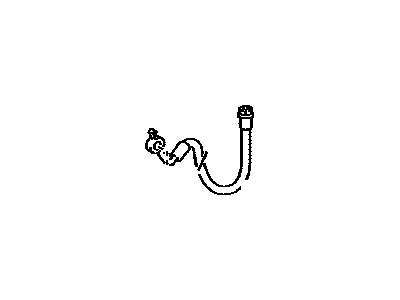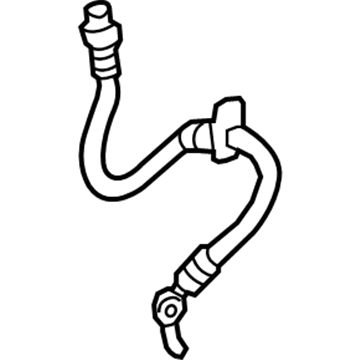×
ToyotaParts- Hello
- Login or Register
- Quick Links
- Live Chat
- Track Order
- Parts Availability
- RMA
- Help Center
- Contact Us
- Shop for
- Toyota Parts
- Scion Parts
My Garage
My Account
Cart
OEM 2009 Toyota RAV4 Brake Line
Brake Hose- Select Vehicle by Model
- Select Vehicle by VIN
Select Vehicle by Model
orMake
Model
Year
Select Vehicle by VIN
For the most accurate results, select vehicle by your VIN (Vehicle Identification Number).
8 Brake Lines found

2009 Toyota RAV4 Flex Hose, Passenger Side
Part Number: 90947-A2044$53.05 MSRP: $73.83You Save: $20.78 (29%)Ships in 1-3 Business DaysProduct Specifications- Other Name: Hose, Flexible; Hydraulic Hose; Brake Hose; Brake Line; Hose, Flexible(For Rear Passenger Side)
- Position: Passenger Side
- Part Name Code: 47318F
- Item Weight: 0.80 Pounds
- Item Dimensions: 7.2 x 6.2 x 1.6 inches
- Condition: New
- Fitment Type: Direct Replacement
- SKU: 90947-A2044
- Warranty: This genuine part is guaranteed by Toyota's factory warranty.
2009 Toyota RAV4 Flex Hose, Rear Driver Side
Part Number: 90947-02F52$56.03 MSRP: $78.00You Save: $21.97 (29%)Ships in 1-3 Business DaysProduct Specifications- Other Name: Hose, Flexible; Brake Hydraulic Hose, Rear Left; Brake Hose; Brake Line; Hose, Flexible(For Rear Driver Side); Brake Hydraulic Hose; Hydraulic Hose
- Position: Rear Driver Side
- Replaces: 90947-02E59
- Part Name Code: 47319F
- Item Weight: 0.70 Pounds
- Item Dimensions: 7.4 x 6.3 x 1.5 inches
- Condition: New
- Fitment Type: Direct Replacement
- SKU: 90947-02F52
- Warranty: This genuine part is guaranteed by Toyota's factory warranty.
2009 Toyota RAV4 Flex Hose, Passenger Side
Part Number: 90947-02F51$56.03 MSRP: $78.00You Save: $21.97 (29%)Ships in 1-3 Business DaysProduct Specifications- Other Name: Hose, Flexible; Brake Hydraulic Hose, Rear Right; Brake Hose; Brake Line; Hose, Flexible(For Rear Passenger Side); Brake Hydraulic Hose; Hydraulic Hose
- Position: Passenger Side
- Replaces: 90947-02E58
- Part Name Code: 47318F
- Item Weight: 0.70 Pounds
- Item Dimensions: 7.4 x 6.4 x 1.6 inches
- Condition: New
- Fitment Type: Direct Replacement
- SKU: 90947-02F51
- Warranty: This genuine part is guaranteed by Toyota's factory warranty.
2009 Toyota RAV4 Flex Hose, Rear Driver Side
Part Number: 90947-A2045$53.05 MSRP: $73.83You Save: $20.78 (29%)Ships in 1-3 Business DaysProduct Specifications- Other Name: Hose, Flexible; Hydraulic Hose; Brake Hose; Brake Line; Hose, Flexible(For Rear Driver Side)
- Position: Rear Driver Side
- Part Name Code: 47319F
- Item Weight: 0.70 Pounds
- Item Dimensions: 7.2 x 6.3 x 1.5 inches
- Condition: New
- Fitment Type: Direct Replacement
- SKU: 90947-A2045
- Warranty: This genuine part is guaranteed by Toyota's factory warranty.
2009 Toyota RAV4 Flex Hose, Driver Side
Part Number: 90947-A2043$121.72 MSRP: $172.31You Save: $50.59 (30%)Ships in 1-3 Business DaysProduct Specifications- Other Name: Hose, Flexible; Hydraulic Hose; Brake Hose; Brake Line; Hose, Flexible(For Front)
- Position: Driver Side
- Part Name Code: 47313J
- Item Weight: 0.80 Pounds
- Item Dimensions: 7.3 x 6.2 x 1.5 inches
- Condition: New
- Fitment Type: Direct Replacement
- SKU: 90947-A2043
- Warranty: This genuine part is guaranteed by Toyota's factory warranty.
2009 Toyota RAV4 Flex Hose, Passenger Side
Part Number: 90947-A2042$121.72 MSRP: $172.31You Save: $50.59 (30%)Ships in 1-3 Business DaysProduct Specifications- Other Name: Hose, Flexible; Hydraulic Hose; Brake Hose; Brake Line; Hose, Flexible(For Front)
- Position: Passenger Side
- Part Name Code: 47313A
- Item Weight: 0.90 Pounds
- Item Dimensions: 7.1 x 6.2 x 1.5 inches
- Condition: New
- Fitment Type: Direct Replacement
- SKU: 90947-A2042
- Warranty: This genuine part is guaranteed by Toyota's factory warranty.
2009 Toyota RAV4 Flex Hose, Front Driver Side
Part Number: 90947-02F50$116.47 MSRP: $163.50You Save: $47.03 (29%)Ships in 1-3 Business DaysProduct Specifications- Other Name: Hose, Flexible; Brake Hydraulic Hose, Front Left; Brake Hose; Brake Line; Hose, Flexible(For Front); Brake Hydraulic Hose; Hydraulic Hose
- Position: Front Driver Side
- Replaces: 90947-02E27
- Part Name Code: 47313J
- Item Weight: 0.80 Pounds
- Item Dimensions: 7.2 x 6.4 x 1.6 inches
- Condition: New
- Fitment Type: Direct Replacement
- SKU: 90947-02F50
- Warranty: This genuine part is guaranteed by Toyota's factory warranty.
2009 Toyota RAV4 Flex Hose, Front Passenger Side
Part Number: 90947-02F49$116.47 MSRP: $163.50You Save: $47.03 (29%)Ships in 1-3 Business DaysProduct Specifications- Other Name: Hose, Flexible; Brake Hydraulic Hose, Front Right; Brake Hose; Brake Line; Hose, Flexible(For Front); Brake Hydraulic Hose; Hydraulic Hose
- Position: Front Passenger Side
- Replaces: 90947-02E26
- Part Name Code: 47313A
- Item Weight: 0.90 Pounds
- Item Dimensions: 7.4 x 6.4 x 1.5 inches
- Condition: New
- Fitment Type: Direct Replacement
- SKU: 90947-02F49
- Warranty: This genuine part is guaranteed by Toyota's factory warranty.
2009 Toyota RAV4 Brake Line
Looking for affordable OEM 2009 Toyota RAV4 Brake Line? Explore our comprehensive catalogue of genuine 2009 Toyota RAV4 Brake Line. All our parts are covered by the manufacturer's warranty. Plus, our straightforward return policy and speedy delivery service ensure an unparalleled shopping experience. We look forward to your visit!
2009 Toyota RAV4 Brake Line Parts Q&A
- Q: How to install the front Brake Line on 2009 Toyota RAV4?A: Installation of the front brake flexible hose starts with checking the identification marker on the hose. The procedure includes using a new gasket to mount the flexible hose onto the disc brake cylinder. Tighten the union bolt to 29 Nm (300 kgf-cm, 22 ft-lbf). Secure the flexible hose lock inside the cylinder lock hole followed by clamping the flexible hose bracket on its corresponding section. The hook part labeled A of the sensor clamp should be hooked onto the flexible hose bracket marked C and the sensor clamp's hook part indicated as B should be inserted into flexible hose bracket D. The bolt (labeled C) should be installed to connect both the flexible hose clamp and sensor clamp with a torque of 19 Nm (189 kgf-cm, 14 ft-lbf). This is followed by attaching the flexible hose with the bolt (labeled D) maintaining a matching torque. The flexible hose installation requires placement at the brake tube connecting point (labeled A) before adding a new clip (labeled B). The flexible hose requires connection to brake tube (labeled A) using a union nut wrench (10 mm) while using a wrench to hold the hose before applying torque. Without the wrench, the recommended torque is 15 Nm (155 kgf-cm, 11 ft-lbf) but with the wrench it should be 14 Nm (145 kgf-cm, 10 ft-lbf). Make sure the torque wrench has a 300 mm (11.8 in.) fulcrum length and maintain the union nut wrench parallel to the torque wrench. Protect the brake tube from bending as well as avoid damaging it but also stop external elements from navigating into the tube connection area. Installation requires filling the brake fluid reservoir before bleeding all air out of the master cylinder as well as the brake line and ABS and traction actuator components. Next check the brake fluid level and search for leakage before tightening the front wheel with 103 Nm (1050 kgf-cm, 76 ft-lbf).
